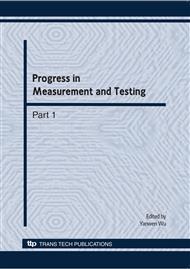[1]
F. Bacchus, S. Dalmao and T. Pitassi, in: Proc. of the 44 th Symposium on Foundations of Computer Science, edited by A. Blum, D. Randall, E. Upfal, IEEE Computer Society, MA, USA (2003), p.340.
Google Scholar
[2]
M. L. Littman, S. M. Majercik and T. Pitassi: J. Auto. Reasoning Vol. 27 (2001), p.251.
Google Scholar
[3]
T. Sang, P. Beame and H.A. Kautz, in: Proc. of the 20th +ational Conf. on Artificial Intelligence, edited by S. Zilberstein, J. Koehler, S. Koenig, AAAI Press, Menlo Park (2005), p.475.
Google Scholar
[4]
R. J. Bayardo, J. D. Pehoushek, in: Proc. of the 17th +ational Conference on Artificial Intelligence, edited by S. Zilberstein, J. Koehler, S. Koenig, AAAI Press, Texas, USA (2000), p.157.
Google Scholar
[5]
T. Sang, F. Bacchus, P. Beame, H. Kautz, and T. Pitassi, in: Proc. of the Seventh International Conference on Theory and Applications of Satisfiability Testingthe, edited by Hans KB, Zhao XS, Springer-Verlag, Berlin, Heidelberg (2004), p.20.
Google Scholar
[6]
T. Sang, P. Beame, and H. Kautz, in: Proc. of the Eighth International Conference on Theory and Applications of Satisfiability Testingthe, edited by Hans KB, Zhao XS, Springer-Verlag, Berlin, Heidelberg (2005), p.226.
Google Scholar
[7]
M. Yin, H. Lin, J. Sun, in: Proc. of the Twenty-Second AAAI Conference on Artificial Intelligence, edited by S. Zilberstein, J. Koehler, S. Koenig, AAAI Press, British Columbia, Canada (2007), p. (1916).
Google Scholar
[8]
M. Yin, H. Lin, J. Sun: Journal of Software Vol. 20(2009), p.1714.
Google Scholar
[9]
F. Bacchus, in: Proc. of the 18 th +ational Conference on Artificial Intelligence, edited by S. Zilberstein, J. Koehler, S. Koenig, AAAI Press, British Columbia, Canada (2002), p.613.
Google Scholar
[10]
R. Bayardo, J. D. Pehoushek, in: Proc. of Seventeenth +ational Conference on Artificial Intelligence and Twelfth Conference on Innovative Applications of Artificial Intelligence, edited by S. Zilberstein, J. Koehler, and S. Koenig, AAAI Press, Menlo Park (2000).
Google Scholar
[11]
H. Lin, J. Sun, Y. Zhang: J. Auto. Reasoning Vol. 31(2003), p.11.
Google Scholar
[12]
J. Sun, Y. Li, X. Zhu, S. Lu: Journal of Computer Research and Development Vol. 46(2009), p.9.
Google Scholar


